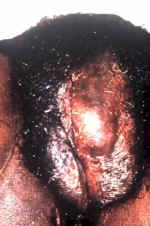|
|
Operational Obstetrics & Gynecology
Vulvar Hematoma
A vulvar hematoma is usually the consequence of a "straddle" injury. When a woman falls while straddling a fixed structure, such as chair, railing, sawhorse or fire hydrant, it is a common occurrence that the peri-clitoral vessels on one side or the other will be crushed against the pubic bone. This results in a vulvar hematoma.

Diagnosis is made on the basis of history of a fall and the typical physical findings of unilateral swelling and pain.
Clinical management consists of:
- An icepack is placed over the perineum and left in place for 24-48 hours. This will help control the pain and limit swelling and further bleeding into the hematoma.
- A Foley catheter is inserted and left in place. The local swelling may be sufficient to impair voluntary voiding and the Foley is much easier to insert earlier in the process.
- Bedrest for several days to a week.
- Appropriate analgesia. Initially, this may need injectable narcotics. Later, oral narcotics and then NSAIDs will give satisfactory results.
- Dramatic resolution will occur. When completely healed in a few weeks, the vulva will look normal and function normally.
- Most of these hematomas will not require surgical exploration and drainage. If you explore them, in about half the cases, no bleeding point will ever be found. Opening them introduces bacteria into an otherwise sterile hematoma. Particularly in operational settings, ice, Foley and bedrest are usually better choices for treatment.
- In following these, it may prove useful to measure the hematoma with a tape measure to compare the size over time. As they are feeling less pain, patients will often feel that the hematoma is enlarging. Having objective measures of its' size will be very reassuring to the patient.
Home · Introduction · Medical Support of Women in Field Environments · The Prisoner of War Experience · Routine Care · Pap Smears · Human Papilloma Virus · Contraception · Birth Control Pills · Vulvar Disease · Vaginal Discharge · Abnormal Bleeding · Menstrual Problems · Abdominal Pain · Urination Problems · Menopause · Breast Problems · Sexual Assault · Normal Pregnancy · Abnormal Pregnancy · Normal Labor and Delivery · Problems During Labor and Delivery · Care of the Newborn
|
Bureau of Medicine
and Surgery |
Operational
Obstetrics & Gynecology - 2nd Edition |
This web version of Operational Obstetrics & Gynecology is provided by The Brookside Associates Medical Education Division. It contains original contents from the official US Navy NAVMEDPUB 6300-2C, but has been reformatted for web access and includes advertising and links that were not present in the original version. This web version has not been approved by the Department of the Navy or the Department of Defense. The presence of any advertising on these pages does not constitute an endorsement of that product or service by either the Department of Defense or the Brookside Associates. The Brookside Associates is a private organization, not affiliated with the United States Department of Defense. All material in this version is unclassified.
This formatting © 2006
Medical Education Division,
Brookside Associates, Ltd.
All rights reserved